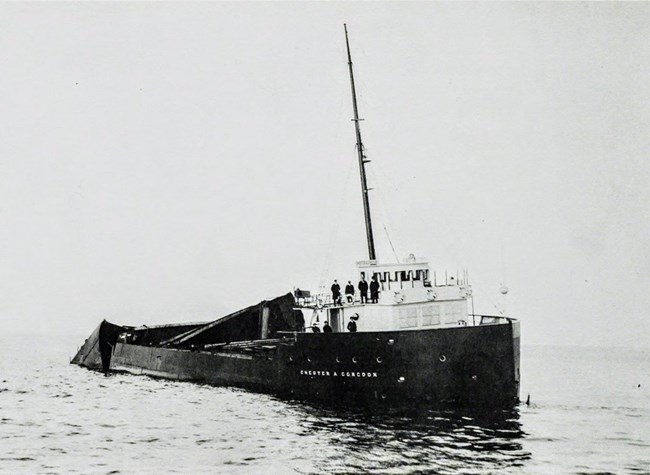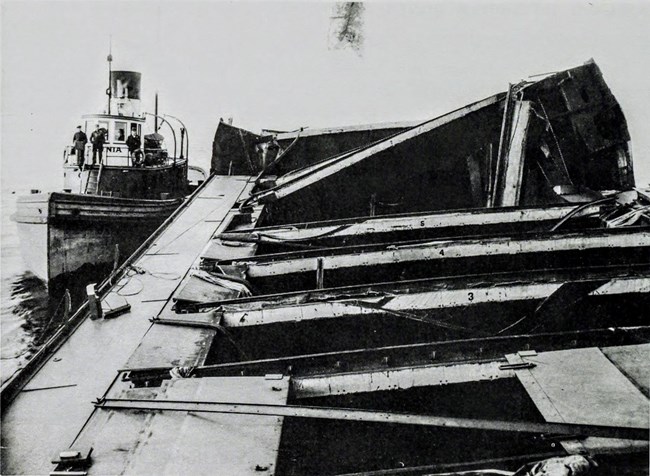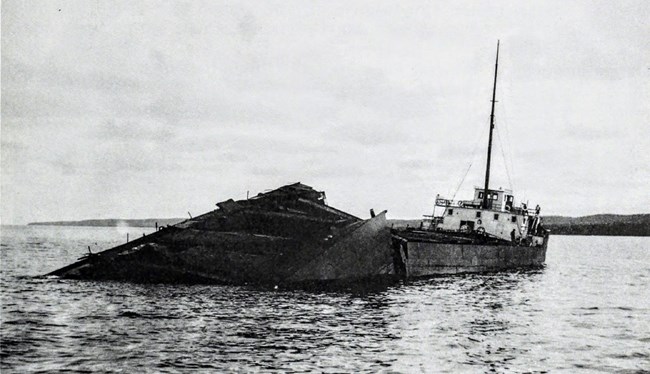Last updated: September 24, 2020
Article
SS Chester A. Congdon: Wreck Event and Survivor Accounts

NPS / Submerged Cultural Resources Center
Wreck Event
The newspaper that contained the first report of the wreck of Chester A. Congdon carried the news on page 10; the headlines and front pages that day were devoted to the news that World War I had ended (Fort William Daily Times Journal, Nov. 7, 1918).
The voyage that would end with one of the most costly marine disasters on the Lakes began on November 6, 1918. At 2:28 am Congdon left Fort William, Ontario, downbound to Port McNicoll with a cargo of 380,000 bushels of wheat (Lake Carriers Association, 1918:142). Other sources list the cargo as 400,000 bushels (Fort William Daily Times Journal, Nov. 12, 1918), and 350,000 bushels (Cleveland Plain Dealer, Nov. 8, 1918). The grain had been loaded at the Ogilvie and Pacific elevators (Fort William Daily Times Journal, Nov. 12, 1918). Congdon had done a 1-day turnaround. The ship arrived on November 5 and cleared downbound on the 6th (Duluth News Tribune, Nov. 6, 1918).
Congdon proceeded a little way past Thunder Cape, where the ship encountered a heavy sea whipped up by a southwest gale. At 4:00 am, Capt. Autterson turned his ship and retreated 7 or 8 miles to calmer water, anchoring until 10:15 am. By then the wind had abated, although the sea was still running. The captain ventured out again, but after passing Thunder Cape, a thick fog set in. A course was set for Passage Island at 10:40 am, and the ship held a speed of 9 knots. The captain's intention was to run for 2.5 hours at that speed and stop if the fog held (Lake Carriers Association, 1918:142-143). "I figured on stopping on account of fog until we could locate something. At 8 minutes after 1:00 in the afternoon she fetched up-grounded (from the captain's account, Fort William Daily Times Journal, Nov. 12, 1918). The ship's officers had not heard the Passage Island fog signal before they struck the southerly reef of Canoe Rocks (Lake Carriers Association, 1918:143).

NPS / Submerged Cultural Resources Center
The second mate brought the first news of the wreck to Fort William. Apparently, Congdon had no wireless aboard, or it was disabled when the ship struck. The historical accounts indicate no messages were transmitted from Congdon.
As soon as word of the disaster reached Fort William, J. Wolvin, manager of the Canadian Towing and Wrecking Company dispatched the wrecking barge Empire and the tug A.B. Conmee to the site. The tug Sarnia, with additional equipment, was being prepared to follow soon (Fort William Daily Times Journal, Nov. 7, 1918).
First reports of damage to the stricken ship indicated that the vessel, although damaged, might be saved. "Her forepeak, Nos. 1 and 2 starboard tanks and No. 1 port tank are full of water" (Cleveland Plain Dealer, Nov. 8, 1918). It was hoped that lightering would be all that was necessary to refloat the vessel. The lightered grain was to be placed aboard the barge Crete (Cleveland Plain Dealer, Nov. 9, 1918).
The most serious obstacle to refloating Congdon would prove to be the weather. When the lightering tugs and barges initially left for the site, the weather had been "calm and thick" (Cleveland Plain Dealer, Nov. 8, 1918), but this did not last long. Two days later, by Friday, strong winds had blown up. The crew was removed from the wreck sometime that day, November 8, and was placed aboard the barge Empire. As the wind blew from the southeast at gale force, reaching a speed of 55 miles per hour (Lake Carriers Association, 1918:143, Cleveland Plain Dealer, Nov. 10, 1918), the crew was sheltered on the barge in protected waters at Isle Royale (Port Arthur Daily Chronicle, Nov. 8, 1918).
No loss of life resulted from the wreck. One serious injury, however, did occur before the lightering operations were concluded, due to the fierce gale that drove the salvage vessels and crew to shelter at Isle Royale. Wireless operator Thomas Ives of the barge Empire was transported to the hospital in Port Arthur with a mangled thigh, which was smashed when he caught his leg in a hoisting gear. He was taken to port on one of the attending tugs (Port Arthur Daily Chronicle, Nov. 7, 1918).

NPS / Submerged Cultural Resources Center
The messages of the wreck that reached land on November 9 relayed the news that Congdon had broken in two, and that the stern had sunk in deep water. The tugs had stood by as long as possible, but there was nothing they could do, although they stayed at the site until heavy seas were breaking over the wreck (Fort William Daily Times Journal, Nov. 9, 1918). The steamer had broken in two aft of the No. 6 hatch sometime Friday night (Nov. 8th). The forward end remained on the reef in 20 feet of water, but was in very bad condition (Fort William Daily Times Journal, Nov. 12, 1918; Lake Carriers Association, 1918:143; Cleveland Plain Dealer, Nov. 10, 1918). The 36-man crew of Congdon returned to Fort William, arriving on the tug Conmee Saturday morning, November 9 (Fort William Daily Times Journal, Nov. 12, 1918). The captain, along with Superintendent Close who had arrived from Duluth to investigate the accident, both visited the wreck on Sunday morning and salvaged personal effects from the bow section.
The ship was declared a total loss. The newspapers noted that four-fifths of the cargo would be lost (Fort William Daily Times Journal, Nov. 12, 1918). The crew arrived in port in time to participate in the Nov. 11, armistice celebrations. The survivors of the Congdon wreck paraded in the streets carrying the ship's flag, and a large crowd fell in behind them (Fort William Daily Times Journal, Nov. 11, 1918). "We expected to be somewhere on Lake Huron today," said one of the crew, "instead of back again at Fort William" (Fort William Daily Times Journal, Nov. 12, 1918).
Congdon's cargo of wheat had been owned by the Wheat Export Company (Canadian Railway and Marine World, 1918:567). The lightering operations were only able to remove about one-fifth of the cargo, some 50,000 to 60,000 bushels.
